
Common problems at sinks in reprocessing departments
Healthcare reprocessing sinks play a central role in the reprocessing of medical devices. Technicians and nurses spend hours using these important pieces of equipment. The critical nature of the work and devices in decontamination, coupled with the long periods of time spent using them, means that when there’s a problem or shortcoming related to a sink, it’s noticeable.
Here are some of the most common problems found with sterile processing and endoscope reprocessing sinks.
Overflows
With no shortage of tasks to be completed in any reprocessing department, there’s little time to waste. That’s especially true when it comes to filling sink basins. Often, technicians will turn on the water and step away to keep working on other tasks (as opposed to watching the basin fill).
Unfortunately, with so much to do and so little time to do it, that sink basin can easily be forgotten, leading to overflows, equipment damage, and slippery floors, as well as time being spent mopping up the overflowed water. Thoughtful sink design will consider this (often too common) occurrence, and account for it in its features.
Basin Volume
Speaking of filling up sink basins, many instructions for use (IFU) call for specific volumes of water to properly rinse and soak devices in a sink basin, mixed with detergents and chemistries. Many departments have gone to either etching their sink basins permanently, or using fill line stickers. Both bring their unique challenges, as permanent etchings are nearly impossible to terminally clean, and stickers can encourage bioburden with their sticky, exposed adhesives or need constant replacement. But without some kind of indicator, it’s easy for cleaning chemistries to improperly diluted, and be less effective.
Soaking Time
Soaking is a part of many device’s IFU, and an important step towards ensuring patient safety. With many departments now soaking devices with longer soak times, but without adding the basin capacity to accommodate it, departments have to juggle their basins more than ever.
The best way to handle this balancing act is using quality timers. Without permanent, dedicated timers on sinks, many departments turn to small, handheld timers. With low visibility of these handheld timers, and alarm volumes that can’t overcome the noise of a bustling reprocessing department, they go unnoticed when soaking time is complete, leading to excess time spend soaking. Excessive soaking can also cause damage in certain situations, furthering the issue.
Alternatively, a lack of any dedicated timers leads to departments approximating the time spent soaking. This can lead to lack of compliance with device IFUs, and potentially impact patient safety at the facility.
Ergonomic Concerns
The considerable amount of time technicians and nurses spend using reprocessing sinks means that any ergonomic challenges or concerns will be greatly amplified. It’s one thing to hunch over a sink for a few minutes, it’s something else entirely to do it for an entire shift.
A major ergonomic challenge regarding sinks is the depth of their basins. Because many sinks being used in SPDs and GI were not originally designed for use in the reprocessing space (or managers being unable to be involved in selecting their sinks in the first place), their basins are often significantly deeper than needed. This results in technicians and nurses hunching and stooping over the sink for long periods of time, leading to musculoskeletal issues and general fatigue.
Beyond the depth of a sinks’ basins, the height of the sink is another major concern related to ergonomics. Fixed height sinks mean that a technician’s height needs to land in a ‘goldilocks’ zone to work comfortably. Anyone above or below that height will have to squat or stretch in order to do their job effectively.
Organizational Challenges
Technicians and nurses require various materials, tools, and equipment to do their job effectively. Without a dedicated space around the sink for these necessities, disorganization can quickly become standard practice, leading to poor processes, reduced productivity, and even compliance concerns that can impact patient safety.
While many departments implement shelving to help facilitate organization and standardize their workflows, changes to guidelines & standards can cause the rigidity of these configurations to lead to the “workaround to becoming the workflow,” resulting in a loss of organization and potentially hindering the adoption of needed changes.
These areas are just the tip of the iceberg when it comes to challenges surrounding reprocessing sinks. The opportunities to improve the quality of life (and work) of the technicians and nurses that use them are countless. Ultimately, the right tool leads to the right outcomes, and a higher standard of patient care.
Pure Processing has seen it all when it comes to healthcare reprocessing sinks. Our designs were built by listening to the challenges of our many customers, and designing solutions around guidelines, department limitations, and IFU requirements. Have a challenge or are interested in exploring ways to enhance your sink situation? Let us know, we’d love to let you know everything available to you and your department!





